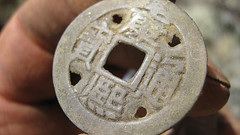
PREV ARTICLE
NEXT ARTICLE
FULL ISSUE
PREV FULL ISSUE
17TH-CENTURY CHINESE COIN FOUND IN YUKON
Dick Hanscom forwarded this story from the BBC News about a recent Chinese coin find in Canada.
-Editor
The find came in July as a team checked the route of a proposed mining road for the Western Copper and Gold Corporation's planned Casino gold mine. The Chinese coin, which is round with a square hole in the centre, helps fill in the blanks on some pre-Gold Rush history. James Mooney, from Ecofor Consulting Ltd., and his team were doing the heritage impact assessment for the proposed mining road. "I was less than a metre from our archeologist Kirby Booker when she turned over the first shovel of topsoil and I caught sight of something dangling from the turf. It was the coin - the neatest discovery I've ever been part of," Mooney said. Mooney believes there's a logical explanation for how the coin found its way deep into the Yukon interior hundreds of years ago. "The first documented accounts of foreigners getting into Tlingit territory were in the mid-1700s. Russian traders [were] coming in and they were collecting sea otter pelts and some of the inland furs, and they would trade things like glass beads, silks and coins," he said. Heritage Canada says the coin was minted between 1667 and 1671. It says the coin adds to the body of evidence that the Chinese market connected with Yukon First Nations through Russian and coastal Tlingit trade. The coin is different from others of its type because it has four additional small holes above each corner of the central square. "The extra holes could have been made in China. Coins were sometimes nailed to a gate, door or ridgepole for good luck. Alternatively, First Nations might have made the extra holes to attach them to clothing," said Mooney. The coins could have been used as decoration or sewn in layers like roofing shingles onto hide shirts to protect warriors from arrows. The coins are more common along the coast, but only three have been found in Yukon. A matrix archeologist found another one in the Kwanlin Dun region this past summer. That was dated between 1724 and 1735. An even older coin was found in 1993 by Beaver Creek, which was dated between 1403 and 1424.
To read the complete article, see:
17th-century Chinese coin found in Yukon
(www.cbc.ca/news/canada/north/story/2011/11/01/north-acient-coin-found.html)
The Numismatic Bibliomania Society is a non-profit organization promoting numismatic literature. See our web site at coinbooks.org. To submit items for publication in The E-Sylum, write to the Editor at this address: whomren@gmail.com To subscribe go to: https://my.binhost.com/lists/listinfo/esylum All Rights Reserved. NBS Home Page Contact the NBS webmaster 
|
